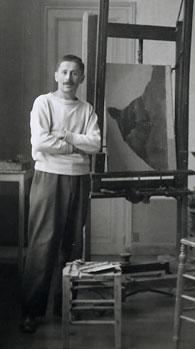Geisha
When E.R. Witten was exposed to the work of Julius Bissier in 1966 (at an exhibition in Boston), he immediately became interested in the Asian influence on the Swiss artist. He studied a number of books that featured Chinese and Japanese art spanning several centuries. Utamaro, an 18th-century Japanese master portraitist of women in the wood-block print tradition (called ukiyo-e) was one of his influences. Witten also admired the soft tones and tranquil natural scenes of the 19th-century artist Hiroshige. He focused on portraits of Geisha, fascinated by their dignified poses and sharp contrasts in color. Witten transformed the traditional portraits into finely balanced and graceful assemblages of geometric shapes.






